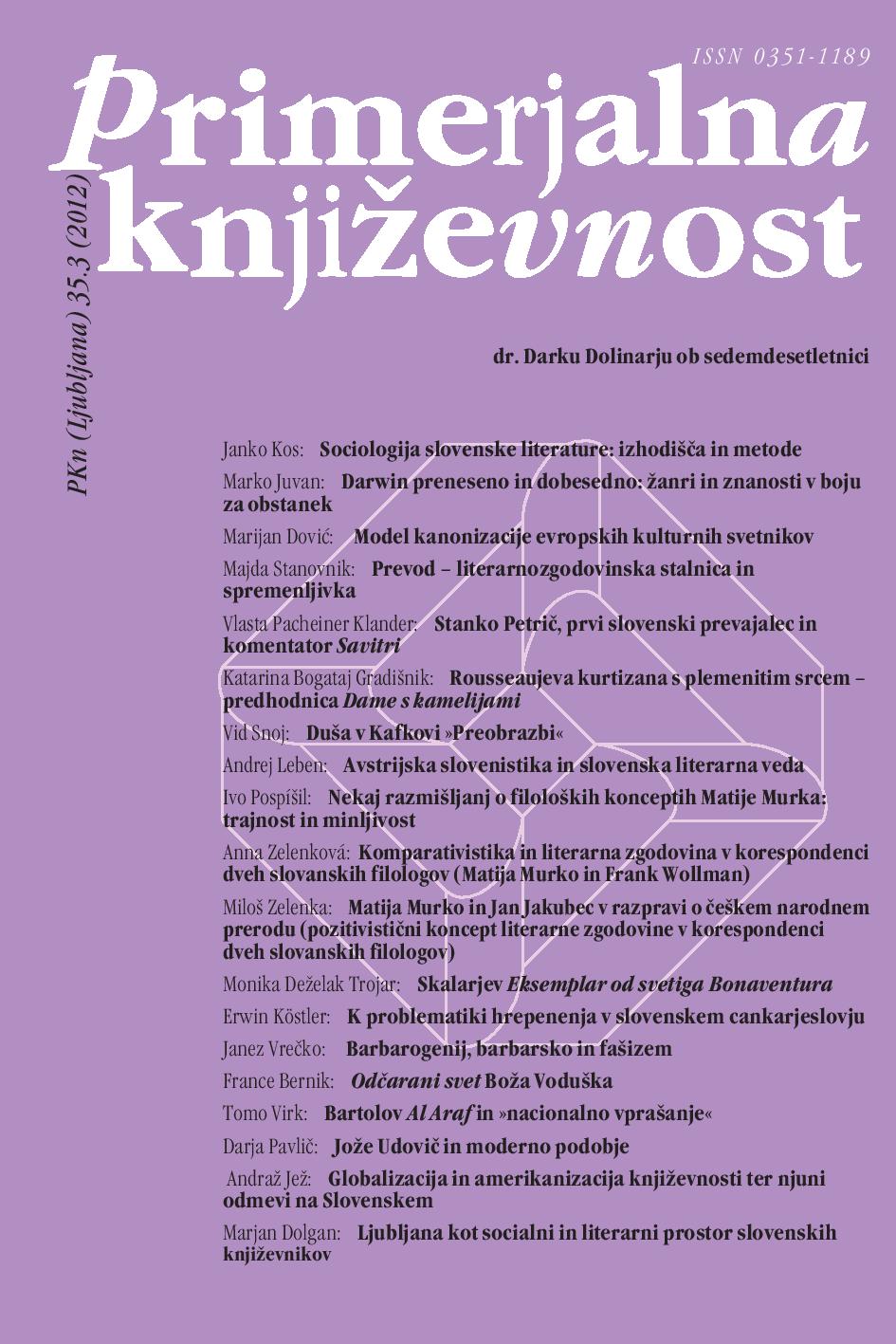Model kanonizacije evropskih kulturnih svetnikov
Ključne besede:
evropska književnost, nacionalne književnosti, kanonizacija, literarni kanon, kulturni spomin, »kulturni svetniki«, nacionalna identiteta, nacionalni pesnikiPovzetek
Razprava predstavi nov model za preučevanje kanonizacije evropskih »kulturnih svetnikov«. Model vključuje študij kanoničnih »potencialov« kandidata (vitae), kanonizacijo v ožjem smislu – tako njene konstitutivne oz. afirmativne vidike (inventio) kot tiste, ki zagotavljajo nenehno reprodukcijo kanoničnosti (cultus) – ter širše družbene implikacije omenjenih procesov (virtutes).Literatura
Abou-El-Haj, Barbara. The Medieval Cult of Saints: Formations and Transformations. Cambridge: Cambridge University Press, 1997.
Abramovich, Dvir. »Bialik, the Poet of the People«. History of the Literary Cultures of East-Central Europe: Junctures and Disjunctures in the 19th and 20th Centuries. (Zv. 4). Ur. Marcel Cornis-Pope in John Neubauer. Amsterdam: John Benjamins, 2010. 128–132.
Assmann, Aleida, in Jan Assmann. »Kanon und Zensur«. Kanon und Zensur. Ur. Aleida in Jan Assmann. München: Wilhelm Fink, 1987. 7–27.
Bell, Catherine. Rituals: Perspectives and Dimensions. Oxford: Oxford University Press, 1997.
Brown, Peter. The Cult of the Saint: Its Rise and Function in Latin Christianity. Chicago: University of Chicago Press, 1982.
Crook, John. The Architectural Setting of the Cult of Saints. Oxford: Oxford University Press, 2000.
Dović, Marijan. »Early Literary Representations of National History and the ‘Slovene Cultural Syndrome’«. Primerjalna književnost 30. Posebna št. (2007): 191–207.
– – –. »France Prešeren: A Conquest of the Slovene Parnassus«. History of the Literary Cultures of East-Central Europe: Junctures and Disjunctures in the 19th and 20th Centuries. (Zv. 4). Ur. Marcel Cornis-Pope in John Neubauer. Amsterdam: John Benjamins, 2010. 97–109.
-– – –. »Nacionalni pesniki in kulturni svetniki: kanonizacija Franceta Prešerna in Jónasa Hallgrímssona«. Primerjalna književnost 34.1 (2011): 147–163.
Egilsson, Sveinn Yngvi. »Nation and Elevation: Some Points of Comparison Between the ‘National Poets’ of Slovenia and Iceland«. Primerjalna književnost 34.1 (2011): 127–146.
Even-Zohar, Itamar. »Culture as Goods, Culture as Tools«. Papers in Culture Research. Tel Aviv: Unit of Culture Research, 2010. 9–14.
Ferguson, Priscilla Parkhurst. Paris and Revolution: Writing the Nineteenth-Century City. Berkeley: University of California Press, 1997.
Hamner, M. Gail. »Cultural Saints«. Religion and American Cultures: An Encyclopedia of Traditions, Diversity, and Popular Expressions. Zv. 2. Ur. Gary Laderman in Luis León. Santa Barbara: ABC-CLIO, 2003. 447–448.
Head, Thomas. »The Cult of the Saints and Their Relics«. http://www.the-orb.net/encyclop/religion/hagiography/cult.htm. (Dostop 20. september 2011).
– – –. »The Holy Person in Comparative Perspective«. http://www.the-orb.net/encyclop/religion/hagiography/compare.htm. (Dostop 20. september 2011).
Head, Thomas (ur.). Medieval Hagiography: An Anthology. New York: Routledge, 2001.
Helgason, Jón Karl. »Relics and Rituals: The Canonization of Cultural ‘Saints’ from a Social Perspective«. Primerjalna književnost 34.1 (2011): 165–189.
– – –. »The Role of Cultural Saints in European Nation States«. Culture Contacts and the Making of Cultures. Ur. Rakefet Sela-Sheffy in Gideon Toury. Tel Aviv: Tel Aviv University, 2011. 245–251.
Hroch, Miroslav. »From National Movement to the Fully-Formed Nation: The Nation-Building Process in Europe«. New Left Review 1.198 (1993): 3–20.
Juvan, Marko. »Literary Self-Referentiality and the Formation of the National Literary Canon: The Topoi of Parnassus and Elysium in the Slovene Poetry of the 18th and 19th Centuries«. Neohelicon 31.1 (2004): 113–123.
– – –. »Romantika in nacionalni pesniki na evropskih obrobjih: Prešeren in Hallgrímsson«. Primerjalna književnost 34.1 (2011): 119–126.
Koropeckyj, Roman. »Adam Mickiewicz as a Polish National Icon«. History of the Literary Cultures of East-Central Europe: Junctures and Disjunctures in the 19th and 20th Centuries. (Zv. 4). Ur. Marcel Cornis-Pope in John Neubauer. Amsterdam: John Benjamins, 2010. 19–39.
Leerssen, Joep. »Nationalism and the Cultivation of Culture«. Nations and Nationalism 12.4 (2006): 559–578.
Martinez, Matias. »Dante und der Ursprung des Kanons«. Kanon und Theorie. Ur. Maria Moog-Grünewald. Heidelberg: Universitätsverlag C. Winter, 1997. 139–152.
Mihăilescu, Călin-Andrei. »Mihail Eminescu: The Foundational Truth of a Dual Lyre«. History of the Literary Cultures of East-Central Europe: Junctures and Disjunctures in the 19th and 20th Centuries. (Zv. 4). Ur. Marcel Cornis-Pope in John Neubauer. Amsterdam: John Benjamins, 2010. 86–96.
Neubauer, John. »Figures of National Poets: Introduction«. History of the Literary Cultures of East-Central Europe: Junctures and Disjunctures in the 19th and 20th Centuries. (Zv. 4). Ur. Marcel Cornis-Pope in John Neubauer. Amsterdam: John Benjamins, 2010. 11–18.
– – –. »Petőfi: Self-Fashioning, Consecration, Dismantling«. History of the Literary Cultures of East-Central Europe: Junctures and Disjunctures in the 19th and 20th Centuries. (Zv. 4). Ur. Marcel Cornis-Pope in John Neubauer. Amsterdam: John Benjamins, 2010. 40–55.
Ozouf, Mona. Festivals and the French Revolution. Prev. Alan Sheridan. London: Harvard University Press, 1991.
Penčev, Boyko. »Hristo Botev and the Necessity of National Icons«. History of the Literary Cultures of East-Central Europe: Junctures and Disjunctures in the 19th and 20th Centuries. (Zv. 4). Ur. Marcel Cornis-Pope in John Neubauer. Amsterdam: John Benjamins, 2010. 117–127.
Prendergast, Thomas A. Chaucer’s Dead Body: From Corpse to Corpus. New York: Routledge, 2004.
Pynsent, Robert B. »Mácha, the Czech National Poet«. History of the Literary Cultures of East-Central Europe: Junctures and Disjunctures in the 19th and 20th Centuries. (Zv. 4). Ur. Marcel Cornis-Pope in John Neubauer. Amsterdam: John Benjamins, 2010. 56–85.
Quinault, Roland. »The Cult of the Centenary, c. 1784–1914«. Historical Research 71.176 (1998): 303–323.
Rigney, Ann. »Embodied Communities: Commemorating Robert Burns, 1859«. Representations 115 (2011): 71–101.
Slapšak, Svetlana. »Petar II Petrović Njegoš: The Icon of the Poet with the Icon«. History of the Literary Cultures of East-Central Europe: Junctures and Disjunctures in the 19th and 20th Centuries. (Zv. 4). Ur. Marcel Cornis-Pope in John Neubauer. Amsterdam: John Benjamins, 2010. 110–116.
Tereskinas, Arturas. »Gendering the Body of the Lithuanian Nation in Maironis’s Poetry«. History of the Literary Cultures of East-Central Europe: Junctures and Disjunctures in the 19th and 20th Centuries. (Zv. 4). Ur. Marcel Cornis-Pope in John Neubauer. Amsterdam: John Benjamins, 2010. 183–192.
Verdery, Katherine. The Political Lives of Dead Bodies: Reburial and Postsocialist Change. New York: Columbia University Press, 1999.


